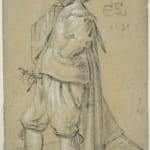
 Cornelis Saftleven - Self-portrait - Fondation Custodia - Paris
Cornelis Saftleven - Self-portrait - Fondation Custodia - Paris
 Cornelis Saftleven - Portrait of a man from behind - CS 15 (PK) - Museum Boijmans van Beuningen - Rotterdam
Cornelis Saftleven - Portrait of a man from behind - CS 15 (PK) - Museum Boijmans van Beuningen - Rotterdam
 Cornelis Saftleven - Portrait of a man - whereabouts unknown
Cornelis Saftleven - Portrait of a man - whereabouts unknown
Cornelis Saftleven
21.6 x 13.8 cm
Plus d'images
-
(View a larger image of thumbnail 1
)

-
(View a larger image of thumbnail 2
)

-
(View a larger image of thumbnail 3
)

-
(View a larger image of thumbnail 4
)

-
(View a larger image of thumbnail 5
)

-
(View a larger image of thumbnail 6
)

-
(View a larger image of thumbnail 7
)

-
(View a larger image of thumbnail 8
)

Provenance
Sotheby's Amsterdam, 26 November 1984, lot 80
Eberhard Walter Kornfeld (1923 - 2023), stamped on reverse (L913b)
This drawing, executed in black chalk and enhanced with white brushwork, is typical of the work of Cornelis Saftleven, a painter and draftsman who lived in Rotterdam for most of his career. Monogrammed and dated 1630, it was executed at the very beginning of the artist's career, who did produce standing figure drawings throughout his life.
1. Cornelis Saftleven
After training as a painter in Rotterdam, Cornelis Saftleven may have visited Antwerp around 1632-4. He seems to have been already quite successful in his early years, as shown by the self-portrait preserved at the Fondation Custodia in Paris, which depicts him in his early twenties, around the time of our drawing.
From 1634 onwards, he stayed for a while in Utrecht, where his brother Herman the Younger had settled. In 1637, Cornelis returned to Rotterdam, where in 1648 he married Catharina van der Heyden (who died in Rotterdam in 1654). The year after her death, he married Elisabeth van der Avondt. In 1667, he became dean of the St. Luke's guild in Rotterdam.
At a time when many artists specialized in a specific genre, Cornelis Saftleven was a versatile artist: he painted portraits, farm interiors, landscapes with livestock, biblical or mythological themes, images of hell, allegories, satire and proverb illustrations. He seems to have been very successful during his lifetime, as evidenced by his inclusion in Van Dyck's Iconography[1] . Documentary evidence exists for around 200 oil paintings, of which 70 are dated between 1629 and 1678, and around 500 drawings (probably less than half his total output), of which 170 are dated between 1625 and 1677.
Cornelis Saftleven is usually drawing with black chalk, more rarely with brush and gray wash. Sometimes, as here, he uses paper prepared with colored wash. Most of his drawings are signed with his characteristic monogram, composed of the letters C, S and L. The shape of the letter S has changed over the years, making it possible to date some sheets that are not. We also know that some of his drawings were engraved; however, there is no documentary evidence that he produced any original engraving by himself.
As with his paintings, Cornelis was more versatile in terms of subjects than most 17th-century Dutch draftsmen. However, he is best known for his life studies of individual figures, influenced by Cornelis Dusart and Gabriel Metsu, or for those of animals and birds. The frequent presence of monograms on his drawings suggests that they were autonomous works, intended directly for sale to amateurs. His drawings are widely represented in the drawing cabinets of major museums.
2. Description and related artworks
Our drawing shows a beardless young man in his early twenties, presumably a comrade of the artist. His sword at his side, his wide-brimmed hat, his fist casually resting on his hip and his cape thrown back, bear witness to his elegance.
The technique is very interesting: it combines black chalk, Saftleven's medium of choice, with white highlights applied with a brush. These slightly transparent highlights protected the blue wash of the paper from fading, revealing the blue color at some places in the background.
Portraits of standing men were one of Saftleven's specialties, and he continued to produce them throughout his career, as illustrated by the one reproduced in the gallery, dated 1666.
3. Framing
Our drawing is presented in a 17th-century Italian blackened wood frame, which has acquired a superb glossy patina over time.
Main bibliographical reference :
David Mandrella La pointe et l'ombre - Dessins nordiques du musée de Grenoble XVIe – XVIIIe siècle Somogy 2014
[1] The third edition of this print refers to him as "Hollandus pictor noctium phantasmatum", a Dutch Painter of Nocturnal Ghosts, reflecting the success of his sabbath scenes and depictions of hell!



